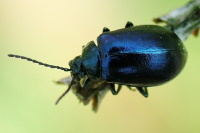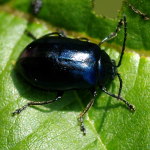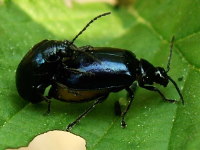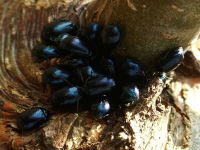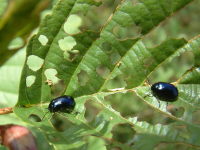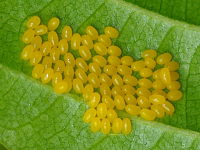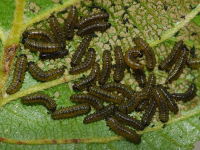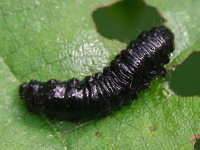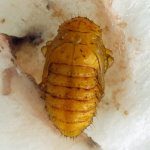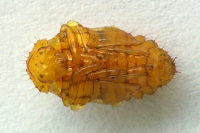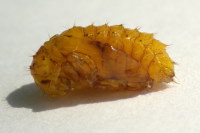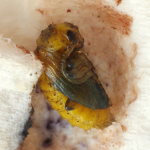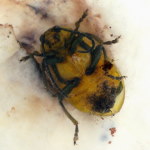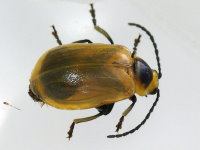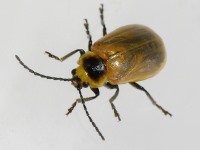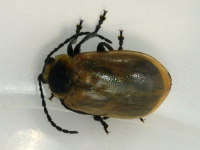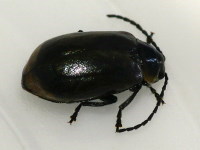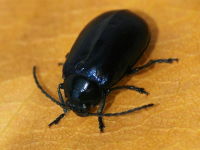Phylum Arthropoda (Arthropods) ➔ Subphylum Hexapoda (Hexapods) ➔ Class Insecta (Insects) ➔ Order Coleoptera (Beetles) ➔ Family Chrysomelidae (Leaf beetles)
Agelastica alni (Linnaeus, 1758)
Blauer Erlenblattkäfer Alder Leaf Beetle
Synonyms and other combinations:
Chrysomela alni Linnaeus, 1758 [original combination] | Adimonia violacea Laicharting, 1781 | Cryptocephalus violacea Geoffroy, 1762 |
Classification:
Agelastica alni belongs to the subfamily Galerucinae.Distribution:
Europe, parts of Asia, North America.Habitat:
Water margins, gallery forests - on grey and black alders.Description:
Agelastica alni is a 6 - 7 mm large, shiny dark blue or blue-violet beetle with finely dotted elytra, which widen significantly towards the hind end. Antennae and legs are black.The larvae, which are mainly black in the last stage, reach a length of up to 11 mm.
Biology:
The Alder Leaf Beetle Agelastica alni forms one generation per year.After overwintering, the adult beetles appear from April. They prefer to feed on freshly sprouting grey and black alders. Birches and willows are only visited when there is a lack of food. After maturation feeding and mating, the females start with oviposition from beginning of May. A female lays on average about 200 - 250 (maximum 400) yellow eggs. These are attached in groups of about 60 - 70 eggs to the undersides of the leaves of the host plants. After 10 - 12 days the larvae hatch. These pass through 3 larval stages in 25 - 30 days. The young larvae, which initially live sociably, separate themselves in the last stage. The adult larvae pupate in an elongated cocoon in the ground. The pupal period lasts 21 - 23 days. The duration of the development is strongly influenced by environmental conditions such as temperature and food supply.
The imagines of the new generation normally hatch in August and September. They feed holes in the leaves of their host plants and, in extreme cases, can skeletonize them.
Agelastica alni hibernates as an imago in the moss or foliage layer near host plants.
Natural enemies:
The Alder Leaf Beetle is parasitized by various species of braconid wasps (Braconidae), ichneumon wasps (Ichneumonidae) and some species of tachina flies (Tachinidae).Note:
The Agelastica alni shown in the pictures from 2013 has pupated in kitchen paper. The orange-yellow pupa changed colour about one day before the beetle hatched. The beetle, which was still light-coloured while hatching, had reached its final blue colour the next day.References, further reading, links:
- Rheinheimer, Joachim, & Hassler, Michael: Die Blattkäfer Baden-Württembergs, 2018, 928 pages, Kleinsteuber Books (Karlsruhe), ISBN 978-3-9818110-2-5
- Agelastica alni
- Altica sp.
- Aphthona nonstriata
- Bromius obscurus
- Bruchus rufimanus
- Bruchus sp.
- Cassida nebulosa
- Cassida rubiginosa
- Cassida sp.
- Cassida stigmatica
- Cassida vibex
- Cassida vibex/bergeali
- Cassida viridis
- Chrysolina fastuosa
- Chrysolina haemoptera
- Chrysolina hyperici
- Chrysolina lucidicollis
- Chrysolina oricalcia
- Chrysolina sp.
- Chrysolina sturmi
- Chrysolina varians
- Chrysomela populi
- Chrysomela tremula
- Chrysomela vigintipunctata
- Clytra laeviuscula
- Clytra quadripunctata
- Coptocephala sp.
- Crepidodera aurata
- Crepidodera aurea
- Crepidodera fulvicornis
- Crioceris duodecimpunctata
- Cryptocephalinae sp.
- Cryptocephalus moraei
- Cryptocephalus nitidus
- Cryptocephalus pusillus
- Cryptocephalus sp.
- Donacia bicolora
- Donacia cinerea
- Donacia marginata
- Donacia versicolorea
- Galeruca tanaceti
- Galerucella s.l.
- Gastrophysa viridula
- Gonioctena decemnotata
- Gonioctena quinquepunctata
- Gonioctena quinquepunctata/intermedia
- Gonioctena sp.
- Gonioctena viminalis
- Lema cyanella
- Leptinotarsa decemlineata
- Lilioceris lilii
- Lochmaea caprea
- Neocrepidodera ferruginea
- Neocrepidodera sp.
- Oulema melanopus/duftschmidi
- Oulema obscura
- Pachybrachis sp.
- Phratora sp.
- Phratora vitellinae
- Phyllobrotica quadrimaculata
- Phyllotreta armoraciae
- Phyllotreta nemorum
- Phyllotreta vittula
- Plagiodera versicolora
- Plagiosterna aenea
- Plateumaris sp.
- Podagrica fuscicornis
- Psylliodes sp.
- Pyrrhalta viburni
- Sphaeroderma sp.
- Xanthogaleruca luteola
